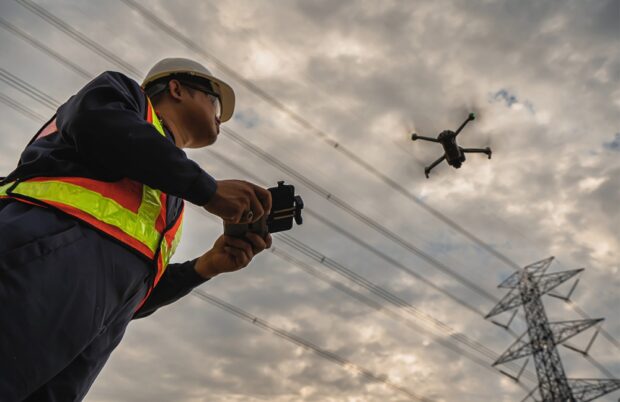Unmanned aircraft systems have emerged as a novel method of inspecting power lines, allowing power utility companies to review the health of their infrastructure more quickly and more safely. But drone operators must maintain a delicate balance, flying close enough to power lines to capture highly detailed images while staying far enough away so as not to be affected by the electromagnetic fields generated by power lines, which interfere with drone operations.
New research from Drexel’s College of Engineering may help shift that balance. In a presentation to the 2023 IEEE Transportation Electrification Conference & Expo, Fei Lu, PhD, assistant professor of electrical and computer engineering (ECE) and Gary Friedman, PhD, professor of ECE, along with collaborators from the University of North Dakota and University of Kansas, quantified the effect that magnetic fields have on drones and offered insight on potential solutions.
The researchers tested a DJI Mavic Pro 2 drone under simulated power line conditions. They sent electricity through large coils to generate magnetic fields similar to those around real-world power lines. The drone was flown at varying distances from the coils while they were energized with different AC current levels.
The tests found that the magnetometer sensors, which work with the accelerometers and gyroscopes to help the drone position itself in the air, were significantly impacted.
“The sensor becomes saturated by the strong magnetic fields, meaning that the signal is larger than their range can measure,” Lu explained. “The drone’s flight control system sends out warnings to the drone operator about this problem, which is good for protecting the drone but effectively limits how close the drone can get.”
The research was funded by the Federal Aviation Administration’s (FAA) Center of Excellence for Unmanned Aircraft Systems, which was looking for insight into the number of drone accidents that occur during power line inspections.
“The navigation difficulties caused by the magnetic fields can sometimes cause drones to crash, causing damage to, at minimum, the drones themselves but also potentially to power infrastructure,” Lu said.
To mitigate the effects of the magnetic fields, the research team proposed solutions like sensor shielding, which could protect the magnetometer, or using sensor fusion methods, which combine data from multiple sensors to provide redundant and accurate navigation information.
“If one sensor (for example, magnetometer) fails, the other sensor can still help the flight control,” Lu explained.
The research provides valuable insights that can help enable the safe and effective use of drones for inspecting vital infrastructure, as their utilization continues to grow. Lu emphasized the importance of continuing to refine drone technologies as more applications emerge across various industries.
“As researchers, we want to make sure these systems operate reliably and safely, especially as they are increasingly relied upon to monitor critical systems like power grids and transportation networks,” Lu said. “It’s crucial that engineers understand environmental factors like magnetic fields and design appropriate navigation techniques. Our work helps move us in that direction.”
Source: Press Release

